 W
WJewish religious clothing is apparel worn by Jews in connection with the practice of the Jewish religion. Jewish religious clothing has changed over time while maintaining the influences of biblical commandments and Jewish religious law regarding clothing and modesty (tzniut). Contemporary styles in the wider culture also have a bearing on Jewish religious clothing, although this extent is limited.
 W
WThe clothing of the people in Biblical times was made from wool, linen, animal skins, and perhaps silk. Most events in the Old and New Testament take place in ancient Israel, and thus most Biblical clothing is ancient Hebrew clothing. They wore underwear and cloth skirts.
 W
WAn ephod was an artifact and an object to be revered in ancient Israelite culture, and was closely connected with oracular practices and priestly ritual.
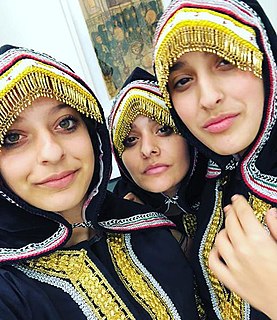 W
WGargush is a traditional Yemenite Jewish headdress, resembling a hood, which is thought to have originated in the Sanaite community.
 W
WThe gartel is a belt used by Jewish males, predominantly Hasidim, during prayer. "Gartel" is Yiddish for "belt". The word comes from the same source as German "Gürtel", which is also cognate with the English "girdle", and "girt".
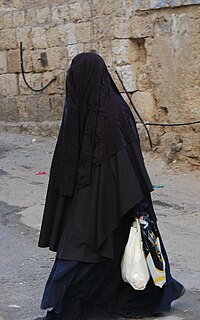 W
WThe Haredi burqa sect, is a religious group within Haredi Judaism, primarily concentrated in Israel, which claims that modesty requires a burqa-style covering of a woman's entire body, a shal, and a veil covering the face. In effect, no skin is exposed to the public. The garment is also called frumka, a play of the word frum and "burqa". The group, which was estimated to number several hundred as of 2011, is concentrated in the town of Beit Shemesh. Members of the sect rarely leave their homes, and are accompanied by their female children, also dressed in long robes, when they do.
 W
WA headscarf is a scarf covering most or all of the top of a person's, usually women's, hair and head, leaving the face uncovered. A headscarf is formed of a triangular cloth or a square cloth folded into a triangle, with which the head is covered.
 W
WThe Jewish hat, also known as the Jewish cap, Judenhut (German) or Latin pileus cornutus, was a cone-shaped pointed hat, often white or yellow, worn by Jews in Medieval Europe and some of the Islamic world. Initially worn by choice, its wearing was enforced in some places in Europe after the 1215 Fourth Council of the Lateran for adult male Jews to wear while outside a ghetto to distinguish them from others. Like the Phrygian cap that it often resembles, the hat may have originated in pre-Islamic Persia, as a similar hat was worn by Babylonian Jews.
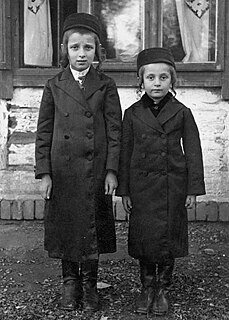 W
WA kashket is a cap, usually made of felt, worn mainly by Hasidic Jewish children as an alternative to the kippah. It has a crown, a band and peak. From the beginning of the 20th century until World War II, many Russian Jews and Polish Jews wore this cap as part of their everyday dress.
 W
WA kippah, also called a koppel or yarmulke, is a brimless cap, usually made of cloth, traditionally worn by Jewish males to fulfill the customary requirement that the head be covered. It is worn by men in Orthodox communities at all times. Among non-Orthodox communities, those who wear them customarily do so only during prayer, while attending a synagogue, or in other rituals. Most synagogues and Jewish funeral parlors keep a ready supply of kippot.
 W
WA kittel is a white linen or cotton robe worn by religious Jews on holidays, in the synagogue or at home when leading the Passover seder. Kittels are sometimes worn by grooms. It is also customary for Jews to be buried in a kittel.
 W
WMitpaḥat, also called a tichel, is the headscarf worn by many married Orthodox Jewish women in compliance with the code of modesty known as ṣniut, which requires married women to cover their hair. Mitpaḥot can range from a plain scarf of any material worn over the hair to elaborate head coverings using multiple fabrics and tying techniques.
 W
WThe priestly breastplate was a sacred breastplate worn by the High Priest of the Israelites, according to the Book of Exodus. In the biblical account, the breastplate is sometimes termed the breastplate of judgment, because the Urim and Thummim were placed within it. These stones were, at times, used to determine God's will in a particular situation. Using these stones did not always determine God's will
 W
WThe priestly crown or frontlet was the golden plate or tiara worn by the Jewish High Priest on his mitre or turban whenever he would minister in the Tabernacle or the Temple in Jerusalem.
 W
WThe priestly sash or girdle was part of the ritual garments worn by the Jewish and priests of ancient Israel whenever they served in the Tabernacle or the Temple in Jerusalem.
 W
WThe priestly mitre or turban was the head covering worn by the High Priest of Israel when he served in the Tabernacle and the Temple in Jerusalem.
 W
WThe priestly undergarments were "linen breeches" (KJV) worn by the priests and the High Priest in ancient Israel. They reached from the waist to the knees and so were not visible, being entirely hidden by the priestly tunic.
 W
WA shtreimel is a fur hat worn by some Ashkenazi Jewish men, mainly members of Hasidic Judaism, on Shabbat and Jewish holidays and other festive occasions. In Jerusalem, the shtreimel is also worn by Litvak Jews. The shtreimel is generally worn after marriage, although it may be worn by boys after bar-mitzvah age in some communities.
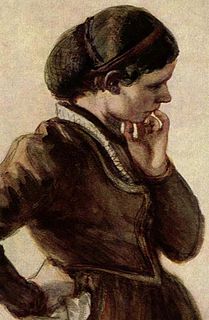 W
WA snood is a type of traditionally female headgear designed to hold the hair in a cloth or yarn bag. In the most common form, the headgear resembles a close-fitting hood worn over the back of the head. It is similar to a hairnet, but snoods typically have a looser fit, a much coarser mesh, and noticeably thicker yarn. A tighter-mesh band may cover the forehead or crown, then run behind the ears, and under the nape of the neck. A sack of sorts dangles from this band, covering and containing the fall of long hair gathered at the back. A snood sometimes was made of solid fabric, but more often of loosely knitted yarn or other net-like material. Historically a small bag of fine thread—netted, tatted, knitted, crocheted, or knotted —enclosed a bob of long hair on the back of the head or held it close to the nape.
 W
WSudra is a piece of cloth usually worn as a scarf or headdress as part of ancient Jewish tradition. Over time it held many different functions and today is sometimes understood to be of great cultural or religious significance to Jews. It is mentioned in various ancient and medieval Aramaic and Greek texts written in or about the Near East among them the Gospel of Luke from around 80–110 CE, the Peshitta from the 1st-2nd century, the Targum Neofiti from around the 1st-4th century, the Babylonian Talmud which was completed around 500 CE – this text makes numerous mentions of the sudra and is an important source for its role in Jewish life at the time – and the Targum Pseudo-Jonathan dated between the 4th century and the 14th century.
 W
WA tallit is a fringed garment worn as a prayer shawl by religious Jews and Samaritans. The tallit has special twined and knotted fringes known as tzitzit attached to its four corners. The cloth part is known as the "beged" and is usually made from wool or cotton, although silk is sometimes used for a tallit gadol.
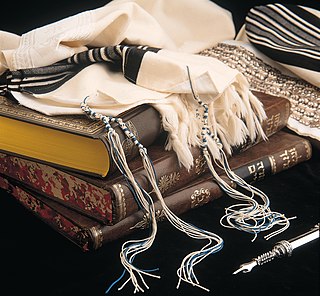 W
WTekhelet is a "blue-violet", "blue", or "turquoise" dye highly prized by ancient Mediterranean civilizations and mentioned 49 times in the Hebrew Bible/Tanakh. It was used in the clothing of the High Priest, the tapestries in the Tabernacle, and the tzitzit (fringes) affixed to the corners of one's four-cornered garments, including the tallit.
 W
WTemple robes describe the ceremonial clothing worn in the performance of ordinances and ceremonies in a temple.
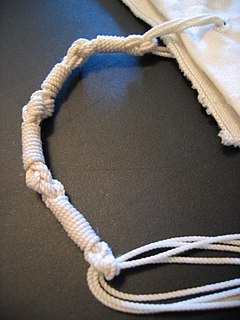 W
WTzitzit are specially knotted ritual fringes, or tassels, worn in antiquity by Israelites and today by observant Jews and Samaritans. Tzitzit are usually attached to the four corners of the tallit gadol, usually referred to simply as a tallit or tallis; and tallit katan. Through synecdoche, a tallit katan may be referred to as tzitzit.
 W
WA wig is a head or hair accessory made from human hair, animal hair, or synthetic fiber. The word wig is short for periwig, which makes its earliest known appearance in the English language in William Shakespeare's The Two Gentlemen of Verona. Some people wear wigs to disguise baldness; a wig may be used as a less intrusive and less expensive alternative to medical therapies for restoring hair or for a religious reason.